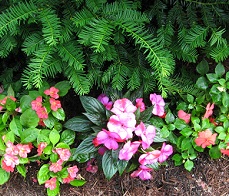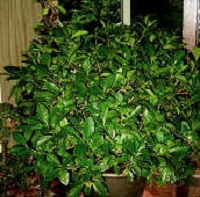Be glad, O people of Zion, rejoice in the LORD your God, for he has given you the autumn rains in righteousness. (Joel 2:23)
With the equinox, fall is officially upon us. But for people like me, fall has been ongoing for a while now: my calendar is a gardening one. The rains are here and the air has a crispness telling the trees to display their colorful best as if it’s a designer’s runway show finale or an end of season spectacular. There are four major gardening checklist items I’m considering at this time of the year:
- Bringing houseplants indoors
- Taking cuttings for growing under lights
- Preparing outdoor plants for winter
- Assessment and replanting

Let’s focus for now on the first two: bringing plants indoors as houseplants or cuttings. The early onset of cool temperatures taught me that Fusion impatiens (pictured far left) won’t tolerate temperatures dropping below 40 the way that other impatiens do. They dropped almost all their leaves. Fortunately, I took cuttings before it got cold so I could grow them under lights inside.
Other extreme measures involved taking my huge hanging baskets down overnight and covering them with frost cloth since the air temperature gets cooler than the garden or ground temperature. The houseplants filling in the reverse side (e.g. beautiful maidenhair fern and Fittonia) might not have handled the cool as well as the ivy. The Nepthytis may be less sensitive than I thought since I noticed the Chicago Botanic Garden had them planted in their fall display beds in their bulb garden. I loved how mine looked and didn’t want to take a chance that they’d be harmed by a night below 40, so I took them all out of the back of the doubled window boxes forming my hanging planters, potted them up and brought them inside.
My process for bringing houseplants indoors involved applying systemic insecticide to them while they were still outdoors. This process began 3 weeks ago knowing that our first frost date is typically around October 16th and houseplants generally need to come in when it’s in the 45 to 50 degree range. There are a few exceptions which I’ll mention in a moment.
I begin with a thorough washing of the leaves of the plants with a gentle spray from the garden hose. That alone, however organic and nice, will not prevent insects from popping up indoors. Systemic insecticides will protect my plants indoors once they’re inside for the winter. But my favorite Bayer product for houseplants (a pill form injected into the soil) doesn’t work immediately so it requires some planning. It also doesn’t work on spider mites which seem to pop up out of nowhere. So the miticide (which smells truly awful) gets applied only while the plants are still outside. I also spray my houseplants with a spray to kill any adults or eggs on the plants that might escape. Few things are worse than infested indoor plants. I do not like to spray chemicals on my plants indoors because the spray droplets in the air can be lethal to both parakeets and fish and therefore, I take an integrated pest management approach outside before bringing things in…to prevent winter problems as best as possible. My indoor controls have been restricted to a long shower in my bathtub, yellow sticky traps and perhaps insecticidal soap, so the Bayer product mentioned above is a welcome alternative.
 When the cold temperatures came, my plants were ready to come inside. I usually plan on doing the indoor-outdoor hokey-pokey dance for a week to ten days with my plants so that they can become acclimated to lower light conditions indoors. The plants come in. The plants go out. The plants come in and turn all about…
When the cold temperatures came, my plants were ready to come inside. I usually plan on doing the indoor-outdoor hokey-pokey dance for a week to ten days with my plants so that they can become acclimated to lower light conditions indoors. The plants come in. The plants go out. The plants come in and turn all about…
Some plants get a drastic haircut because they won’t fit in my house and let me live there too. My gardenia (pictured post-haircut with cuttings used for a new plant) and the “nasty-wasty-30-year-old-sour-orange-tree” which I will feature in an article someday are both simply too big and get cut back since south windows in my home are at a premium. The sour orange stays out until absolutely necessary since it’s my husband’s sentimental plant even though it grows huge thorns and has no redeeming value. One would hope it might flower some day, but at the age of 30 it’s had years of opportunity and all kinds of therapy. We don’t hope for too much from it.
Among the other plants I leave out until it is very cold (but not freezing) are my cymbidium orchids. They need cold temperatures to set their flower buds. The reward is well worth careful attention to it! Many varieties of ivy can handle cold temperatures, some even below freezing so I have been known to use them in fall planters until even the mums give up the ghost. Finally, there are my Boston ferns. The cooler temperatures and reduced natural light intensity help to prepare them for bringing back indoors. It also gives me plenty of opportunity to let them shed dead leaflets (called pinnae) outside so that I will not spend as much time sweeping them up inside.
With smart, tender loving care, houseplants will help to brighten the long winter days. They add a living touch to every room and careful planning to insect prevention and acclimation to lower indoor light levels will mean that they’ll be a joy and not a burden.